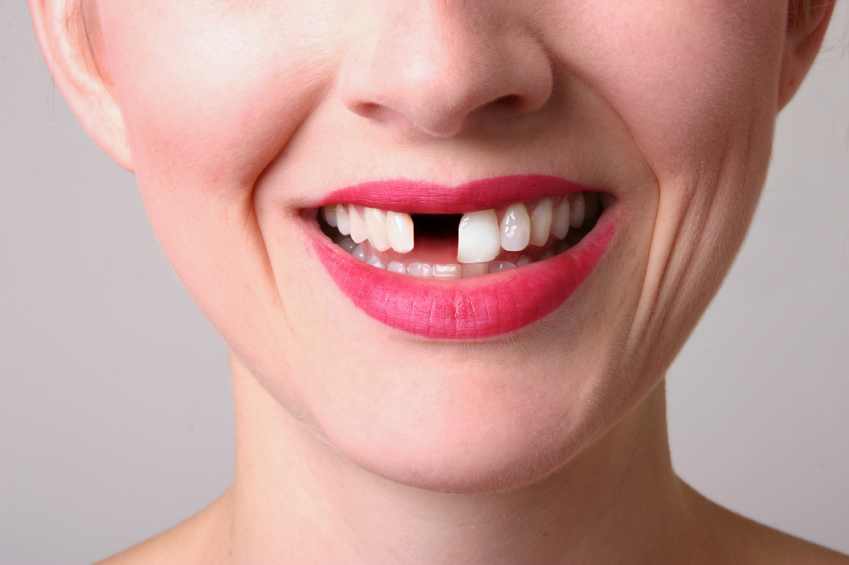As children we all experience tooth loss: Our baby teeth start to fall out at about the age of 6 to make way for our permanent teeth. If all goes well, our “adult” teeth will grow in without a hitch and stay there for the rest of our lives.
Unfortunately, keeping your teeth for a lifetime isn’t always the case. Adults experience missing teeth due to several reasons: teeth lost or extracted due to dental problems, teeth that are knocked out by trauma or injury, or teeth that never formed or descended after primary teeth fell out. Although a missing tooth might look cute on a six-year-old, it’s no laughing matter once you grow up. Lost adult teeth cannot be replaced, and the tooth fairy definitely isn’t going to put a quarter under your pillow!
More Than Just a Pretty Face
Going toothless isn’t exactly aesthetically pleasing. Those with gaps and open spaces may not smile for fear of showing off their lack of pearly whites. This can hurt one’s self-esteem, impact their social life and even lead to depression.
But if you don’t mind how your smile looks, consider the physical problems that missing teeth cause:
Affects Diet — A patient with missing teeth or significant gaps between teeth may have trouble chewing food. If all teeth are missing, patients will be reduced to “gumming” their meals and their diet will have to be adjusted to softer foods.
Trouble Speaking — Based on the position of the missing tooth or teeth, the patient may experience problems with speech.
Biting Force Changes — The force your jaw exerts while biting and chewing changes to compensate for tooth loss, causing more stress and possible damage to existing teeth.
Crooked Teeth — The resulting pressure on existing teeth will cause them to shift. Jaw pain is often a side effect of shifting teeth.
Tooth Decay — Teeth that have shifted from the pressure tend to be harder to clean, as dental tartar between crooked teeth is more difficult to reach. Regardless of how well you practice good oral hygiene, dental plaque can build up and lead to cavities and gum disease.
Bone Loss — Your teeth are actually what stimulate your jawbone. If a tooth is missing, the bone begins to deteriorate and gums begin to shrink. The more bone that is lost, the harder it is to use dental implants to replace teeth.
Premature Aging — Complete tooth loss will cause the jaw to shrink and the structure of the face to collapse. The lack of structure forces the skin to sag and creates a hollow appearance in the cheeks.
Closing the Gap
As you can see, one thing leads to another, and the results can be devastating. Like most dental problems, the dramatic effects produced by missing teeth will increase unless treated. Luckily, there are ways to “fill the void” that a missing tooth creates:
Full Dentures — In the case where all teeth have been extracted, a complete set of dentures are used. A full set of fake teeth are placed on a plastic base that fits over the gums. Dentures often need to be readjusted to cope with the changes in gum and bone structure.
Partial Dentures — One or more missing teeth can be replaced with a partial denture. One or several crowns are attached to a metal frame, which then clasps onto neighboring teeth for support. Also called a flipper, a partial denture is removable.
Dental Bridges — A dental bridge also use a series of dental crowns to replace one or several teeth in a row. But, unlike partial dentures, bridges are a permanent solution to missing teeth. The crowns are cemented onto surrounding teeth to keep the bridge in place.
Dental Implants — Perhaps the most stable of all the treatments, dental implants are surgically placed into the jaw bone. After an implant heals, a dental crown is attached to the top of the implant, securing the fake tooth and preventing it from moving. Implants can also be used to anchor dentures into place. Patients must meet certain health requirements and maintain a significant amount of jaw bone to qualify as a candidate for implants.
The Support System
Of course, the more measures you take to preserve your natural teeth, the less chance you’ll have of replacing them down the line. Eating healthy and practicing excellent oral hygiene can limit tooth decay and periodontal disease, which are both culprits of tooth loss. Avoid outside elements that cause long-term dental problems, such as smoking and chewing tobacco.
Children should take precautions toward tooth loss as well. If you notice an adult tooth has not come in yet, take the child in for a dental checkup. An X-ray will be able to tell your dentist whether the tooth is impacted or missing due to a genetic defect. To prevent knocking out a tooth, make sure children wear mouthguards during any sports activity — and that goes for you too!
As always, be sure to have regular dental visits to prolong the life of your teeth. If you do have missing teeth. Remember, only a dentist can help you decide which dental treatment is best for you. The better your dental care, the less you’ll have to worry about your teeth making an early exit!

